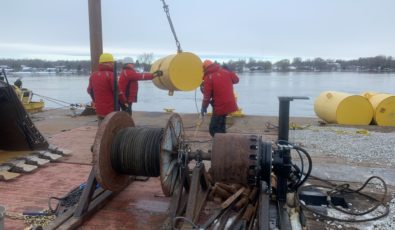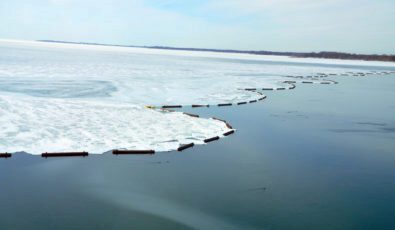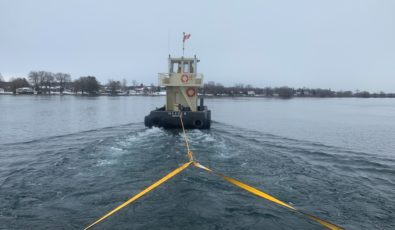Ice booms keep rivers flowing and winter's deep freeze at bay
A sure-fire sign that winter is upon us is the sight of ice booms being installed in the St. Lawrence and Niagara rivers.

The annual installation of steel, wood and cable takes place in November and December to prepare for the plunging temperatures and icy buildup. Without the ice booms, hydroelectric power production on these crucial rivers would be seriously impeded and the risk of flooding greatly increased.
“The Lake Erie-Niagara River ice boom helps facilitate the formation of a natural ice arch,” said Jessica Polak, OPG’s Vice-President of South Central Operations. “This arch forms into place behind the ice boom and helps prevent ice from flowing down into the water intakes of the power generating stations.”
The Niagara River ice boom, which is owned and operated by OPG and the New York Power Authority, consists of a 2.7-kilometre span of floating steel pontoons linked together by steel cables and anchored to the river bottom. Starting from the mouth of the Niagara River near Buffalo, New York, the ice boom extends to the shore of Fort Erie, Ont., keeping the ice at bay while allowing the water to flow freely beneath.
"[The] arch forms into place behind the ice boom and helps prevent ice from flowing down into the water intakes of the power generating stations.”Jessica Polak, Vice-President of OPG's South Central Operations

The barrier is installed when the water temperature in Lake Erie hits 4 C or when the calendar reads Dec. 16, whichever comes first.
It has been constructed every year since 1964, first using wooden timbers before a switch was made to 15-foot and 30-foot-long steel pontoons in 1997. The conversion to steel pontoons improved the boom’s buoyancy, making it harder for ice to overtop the structure and allowing the boom to resurface sooner during an ice event.
On the St. Lawrence River, crews still use timbers to construct the ice booms. Here, 30-foot-long Douglas fir timbers are connected by steel cable to create a 500-foot-long boom section, which is typically made of 15 timbers. Each section is secured by massive steel anchors buried in the riverbed. The ice booms are put into place by a tug boat in six different locations on the river between Prescott and Cardinal.

A fixture on the St. Lawrence River every winter since 1959, the ice boom was initiated after workers at OPG’s R.H. Saunders Generating Station first encountered problems with ice buildup that threatened to damage the station’s equipment after it opened in 1958.
Today, the booms not only promote the formation of even ice cover in the winter, they also promote a controlled and even breaking of the ice in the spring. Typically, the booms on the St. Lawrence are removed in March, when the ice has begun to break up and before the St. Lawrence Seaway opens for the shipping season.
On the Niagara River, the ice boom is usually lifted around April 3, but it all depends on how extensive the Lake Erie ice cover is. In 1971, the ice boom wasn’t removed until May 3, the latest on record.
Subscribe and stay informed
Sign up to receive the latest news, project updates, and event information from OPG.